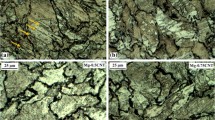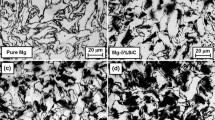Abstract
Magnesium matrix nanocomposites (Mg-Sm2O3 nanocomposites in the present study), containing nanosize reinforcements within the magnesium or magnesium alloy matrix, are a group of energy-saving novel material with enhanced strength-to-weight ratio. However, in order to scale up the applications of the magnesium nanocomposites toward industrial dimensions, detailed response of the materials at ambient and elevated temperatures must be established. Having said this, the primary objective of this paper is to obtain an in-depth understanding of small-scale property–microstructure-composition correlation at ambient (298 K) temperature up to 473 K using a depth sensing nanoindentation testing approach as well as advanced microstructural characterization. Mg-Sm2O3 nanocomposites with 0.5, 1.0, and 1.5 vol% Sm2O3 were compared against pure Mg. The properties measured are reduced modulus, elastic modulus, hardness, indentation creep rate, indentation creep exponent, thermal activation volume, as well as indentation size effect as a function of temperature. Pure Mg and Mg-1.0 Sm2O3 nanocomposite provided the least and the greatest creep resistance, respectively. This is attributed to the presence of thermally stable Sm2O3 nanoparticles which can effectively produce dislocation pile-ups and dislocation tangling.








Similar content being viewed by others
Notes
These nanosize particles are insoluble in the matrix therefore raising temperature does not coarsen or dissolve them. This feature directly contributes to the enhanced strengthening of the material not only at ambient but also at elevated temperatures.
References
Pollock TM (2010) Weight loss with magnesium alloys. Science 328:986–987
Lu K (2010) The future of metals. Science 328:319–320
Nie JF, Zhu YM, Liu JZ, Fang XY (2013) Periodic segregation of solute atoms in fully coherent twin boundaries. Science 340:957–960
Erbel R, di Mario C, Bartunek J, Bonnier J, de Bruyne B, Eberli FR, Erne P, Haude M, Heublein B, Horrigan M, Ilsley C, Böse D, Koolen J, Lüscher TF, Weissman N, Waksman R, PROGRESS-AMS (Clinical Performance and Angiographic Results of Coronary Stenting with Absorbable Metal Stents) Investigators (2007) Temporary scaffolding of coronary arteries with bioabsorbable magnesium stents: a prospective, non-randomised multicentre trial. Lancet 369:1869–1875
Knochel P (2009) Nat Chem 1:740
Nie J-F (2012) Precipitation and hardening in magnesium alloys. Metall Mater Trans A 43:3891–3939
Goh CS, Wei J, Lee LC, Gupta M (2006) Simultaneous enhancement in strength and ductility by reinforcing magnesium with carbon nanotubes. Mater Sci Eng A 423:153–156
Hassan SF, Gupta M (2006) Effect of length scale of Al2O3 particulates on microstructural and tensile properties of elemental mg. Mater Sci Eng A 425:22–27
Dieringa H (2011) Properties of magnesium alloys reinforced with nanoparticles and carbon nanotubes: a review. J Mater Sci 46:289–306
Ghasemi A, Penther D, Kamrani S (2018) Mater Charact 142:137–143
Mirza FA, Chen DL (2015) A unified model for the prediction of yield strength in particulate-reinforced metal matrix nanocomposites. Materials 8:5138–5153. https://doi.org/10.3390/ma8085138
Ferkel H, Mordike BL (2001) Mater Sci Eng A 298:193–199
Katsarou L, Mounib M, Lefebvre W, Vorozhtsov S, Pavese M, Badini C, Molina-Aldareguia JM, Jimenez CC, Prado MTP, Dieringa H (2016) Materials Science & Engineering A 659:84–92
Sourav G, Mondal AK (2018) Mater Sci Eng A 718:377–389
Oliver WC, Pharr GM (1992) J Mater Res 7:1564–1583
Wang CL, Lai YH, Huang JC, Nieh TG (2010) Scr Mater 62:175–178
Su CJ, Herbert E, Sohn S, Manna JAL, Oliver WC, Pharr GM, Mech Phys J (2013) Sol. 61:517–536
Liu X, Zhang Q, Zhao X, Yang X, Luo L (2016) Mater Sci Eng A 676:73–79
Haghshenas M, Islam R, Wang Y, Cheng YT, Gupta M (2018) J Compos Mater. https://doi.org/10.1177/0021998318808358
Haghshenas M, Wang Y, Cheng Y-T, Gupta M (2018) Mater Sci Eng A 716:63–71
Sankaranarayanan S, Gupta M (2015) Powder Metall 58:183–192
Kujur MS, Mallick A, Manakari V, Parande G, Tun KS, Gupta M (2017) Metals 7:357. https://doi.org/10.3390/met7090357
Fei W, Kewei X (2004) Mater Lett 58:2345–2349
Zhu X, Liu X, Zeng F, Pan F (2010) Mater Lett 64:53–56
Shen BL, Itoi T, Yamasaki T, Ogino Y (2000) Scr Mater 42:893–898
Li WB, Henshall JL, Hooper RM, Easterling KE (1991) Acta Mater 39:3099–3110
Sargent PM, Ashby M (1992) Indentation creep. Mater Sci Technol 8:594–601
Mayo M, Siegel R, Narayanasamy A, Nix W (1990) J Mater Res 5:1073–1082
Mahmudi R, Geranmayeh AR, Khanbareh H, Jahangiri N (2009) Mater Des 30:574–580
Mukherjee AK, Bird JE, Dorn JE (1969) Trans ASM 62:155–179
Reed-Hill RE, Abbaschian R, Abbaschian R (1973) Physical metallurgy principles. Cengage Learning, Stamford, CT, USA
Robson JD, Henry DT, Davis B (2009) Acta Mater 57:2739–2747
Parande G, Manakari V, Wakeel S, Kujur MS, Gupta M (2018) Metals 8(12):1014. https://doi.org/10.3390/met8121014
Gupta M, Ling M (2011) Magnesium technology. Wiley-VCH, Weinheim
Hassan SF, Gupta M (2005) Mater Sci Eng 392:163–168
Goh CS, Wei J, Lee LC, Gupta M (2007) Acta Mater 55:5115–5121
Tun KS, Jayaramanavar P, Nguyen QB, Chan J, Kwok R, Gupta M (2011) Mater Sci Technol 28:582–588
Zhong XL, Wong WLE, Gupta M (2007) Acta Mater 55:6338–6344
Haghshenas M, Gupta M (2019) Def Technol. https://doi.org/10.1016/j.dt.2018.08.008
Saboori A, Padovano E, Pavese M, Badini C (2018) Materials (Basel) 11(1):27. https://doi.org/10.3390/ma11010027
Nie KB, Wang XJ, Wu K, Hu XS, Zheng MY (2012) Mater Sci Eng A 540:123–129
Musil J, Kunc F, Zeman H, Polakova H (2002) Surf Coat Technol 154:304–313
Maja ME, Falodun OE, Obadele BA, Oke SR, Olubambi PA (2018) Ceramics International 44:4419–4425
Greer JR, Oliver WC, Nix ED (2005) Acta Mater 23:1821–1830
Nix WD, Gao HJ (1998) Mech Phys Solids 46:411–425
Oliver F, Trenkle JC, Schuh CA (2010) J Mater Res 25(7):1225–1229
Prasitthipayong A, Vachhani SJ, Tumey SJ, Minor AM, Hosemann P (2018) Acta Mater 144:896–904
Sherby OD, Burke PM (1968) Prog Mater Sci 13:325–389
Mohamed FA, Park KT, Lavernia EJ (1992) Mater Sci Eng A 150:21–35
Weertman J (1957) J. Appl. Phys. 28(3):362–364
Weertman J (1957) Appl Phys 28(4):1185–1189
Somekawa H, Hirai K, Watanabe H, Takigawa Y, Higashi K (2005) Mater Sci Eng A 407:53–61
Kumar H, Chaudhari GP (2014) Mater Sci Eng A607:435–444
Lu S, Foo AQ, Wang S, Chen Z (2017) J Alloys Compd 729:498–506
Author information
Authors and Affiliations
Corresponding author
Additional information
Publisher’s note
Springer Nature remains neutral with regard to jurisdictional claims in published maps and institutional affiliations.
Rights and permissions
About this article
Cite this article
Haghshenas, M., Muhammad, M., Hasannaeimi, V. et al. Ambient and non-ambient temperature depth-sensing indentation of Mg-Sm2O3 nanocomposites. Int J Adv Manuf Technol 105, 2947–2956 (2019). https://doi.org/10.1007/s00170-019-04583-4
Received:
Accepted:
Published:
Issue Date:
DOI: https://doi.org/10.1007/s00170-019-04583-4




